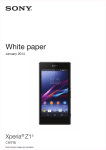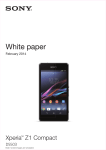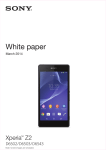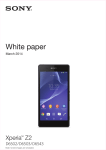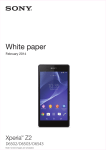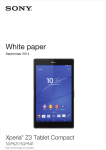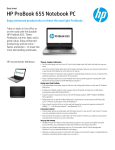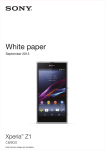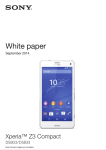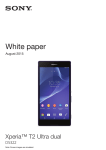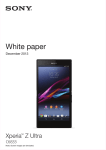Download Sony Xperia Z2 32GB White
Transcript
White paper In t er n al us e on ly January February2014 2014 Xperia™T2Z2 Tablet Xperia TM SGP521/SGP541/SGP551 Note: Screen images are simulated. White paper | Xperia™ Z2 Tablet Purpose of this document Sony product White papers are intended to give an overview of a product and provide details in relevant areas of technology. Document history Version February 2014 First released version Version 1 Sony Mobile Developer World For the latest technical documentation and development tools, go to www.sonymobile.com/developer. This document is published by Sony Mobile Communications AB, without any warranty*. Improvements and changes to this text necessitated by typographical errors, inaccuracies of current information or improvements to programs and/or equipment may be made by Sony Mobile Communications AB at any time and without notice. Such changes will, however, be incorporated into new editions of this document. Printed versions are to be regarded as temporary reference copies only. This White paper is published by: Sony Mobile Communications AB, SE-221 88 Lund, Sweden www.sonymobile.com © Sony Mobile Communications AB, 2009-2014. All rights reserved. You are hereby granted a license to download and/or print a copy of this document. Any rights not expressly granted herein are reserved. *All implied warranties, including without limitation the implied warranties of merchantability or fitness for a particular purpose, are excluded. In no event shall Sony or its licensors be liable for incidental or consequential damages of any nature, including but not limited to lost profits or commercial loss, arising out of the use of the information in this document. First released version (February 2014) Publication number: 1281-4562.1 2 February 2014 White paper | Xperia™ Z2 Tablet Table of contents Product overview ..........................................................................................................2 Highlights ...............................................................................................................2 Facts – dimensions, weight, performance and networks ......................................4 Categorised feature list ..........................................................................................6 Technologies in detail ...................................................................................................9 Device-to-device communications (local) .............................................................9 ANT+™ wireless technology...............................................................................9 Bluetooth® wireless technology .......................................................................10 Wi-Fi® ...............................................................................................................11 DLNA Certified® (Digital Living Network Alliance) ............................................12 Messaging ...........................................................................................................13 MMS (Multimedia Messaging Service)..............................................................13 Email .................................................................................................................13 Positioning – location based services .................................................................14 Provisioning (OMA CP) ........................................................................................14 Multimedia (audio, image and video) ...................................................................15 Synchronisation (OMA DS, EAS, Google Sync™) ...............................................17 Web browser .......................................................................................................17 Memory in Android™ devices .............................................................................18 Trademarks and acknowledgements ..................................................................22 1 February 2014 White paper | Xperia™ Z2 Tablet Product overview Highlights • 10.1-inch Full HD display with the latest BRAVIA® TV technology and X-Reality™ for mobile picture engine • S-Force Front Surround audio technology and Digital noise cancelling • The slimmest (6.4mm) and lightest (under 450g) waterproof tablet on the market • The world’s most powerful tablet – LTE and Snapdragon quad-core 2.3 GHz processor • Powerful 6000 mAh battery with STAMINA mode The sharpest images with the most vivid colours Whether you are in bright daylight or in low light conditions, with the Xperia™ Z2 Tablet, you still can watch entertainment in full, vivid colour. The Xperia™ Z2 Tablet’s 10.1-inch Full HD display is embedded with the latest Sony BRAVIA TV technology expertise. At its core, TRILUMINOS™ Display for mobile creates a wider palette of rich, natural tones while brand new Live Colour LED technology provides the world’s most vivid and deepest colours on a tablet without the risk of oversaturation. Finally, unique to Sony, the X-Reality™ for mobile picture engine analyses each image to optimize colour, sharpness and contrast while super resolution reproduces lacking pixels. So you always get the sharpest images and videos, even from low quality content such as still pictures and web videos. The clearest sound quality When holding a tablet your hand can sometimes get in the way of the speakers. But with Sony’s new SForce Front Surround audio technology coming at you via specially positioned speakers at the front of the Xperia Z2, you can enjoy dynamic sound as it was intended at over 100 DB. And if you are on the move and want to watch your favourite film, you no longer need to worry about the background noise from busy streets, noisy trains or even on flights. The Xperia™ Z2 Tablet supports digital noise cancelling technology which reduces ambient noise by up to 98%. Just make sure you use your Digital Noise Cancellation Headset. The world’s slimmest and lightest tablet The Xperia™ Z2 Tablet is created with a sleek design using premium material, which makes it the Xperia™ Z2 Tablet slimmest (only 6.4mm) and lightest (under 450g) waterproof tablet on the market. Specifically, the Wi-Fi-only model weighs 426g while the 4G LTE modem model weighs 439g. Every single detail has been carefully crafted so you can enjoy a tablet that is not only beautiful to look at, but is also extremely portable and comfortable to hold with just one hand. The durable waterproof tablet The Xperia™ Z2 Tablet is designed with a display that is scratch resistant and a body that is entirely waterproof so it can handle whatever life throws at it. You can even watch a movie in the bath while you relax at the end of the day, or record a video in the pool while on holiday. The Xperia™ Z2 Tablet is built to follow you wherever you go. The world’s most powerful tablet The Xperia™ Z2 Tablet combines the fastest processor in a tablet with Sony’s latest battery saving technology, for fast and long lasting performance. We developed the Snapdragon 801 processor with speeds of up to 2.3 GHz so that just the right processing components are used at the right power levels for any given task. So, share your photos and files faster and stream your audio and video more smoothly with the industry’s only third generation 4G LTE modem, delivering twice as fast 4G user speeds. Plus, a 2 February 2014 White paper | Xperia™ Z2 Tablet generous 3GB of RAM ensures plenty of memory capacity. And if that wasn't enough, you can enjoy sharp, realistic mobile 3D gaming with the enhanced graphics capabilities of the newest Adreno 330 GPU, which delivers a 20% performance improvement over the previous generation. A longer-lasting battery A 6000mAh ion battery and STAMINA Mode features are introduced in the Xperia™ Z2 Tablet, providing up to 10 hours of uninterrupted multimedia usage. Extended standby time maximises your battery lifetime by preventing unwanted applications and data communication from running in the background when the display is turned off. So you won’t miss any important calls. Extended usage runtime can dynamically tune the hardware parameters to reduce performance in favour of longer usage time, so you gain 15 percent power saving even when you’re extra active. With STAMINA mode you can also benefit from extended music playback, allowing you to listen to music for more than 100 hours without having to recharge your battery. And that is something! 3 February 2014 White paper | Xperia™ Z2 Tablet Facts – dimensions, weight, performance and networks Operating system Google™ Android™ 4.4 (KitKat) Processor 2.3 GHz Qualcomm MSM8974AB Quad Core GPU Adreno 330 Size 172 x 266 x 6.4 mm Weight 439 grams Available colours Black, White (SGP521) Black (SGP541, SGP551) SIM card micro SIM Main screen Colours 16,777,216 colour TFT Resolution WUXGA 1920x1200 pixels Size (diagonal) 10.1 inches Scratch-resistant Chemical tempered glass + Anti fingerprint coating Input mechanisms Text input On-screen QWERTY keyboard Touch screen Capacitive Touch gesture Yes – multi-touch, up to 10 fingers supported Memory RAM 3 GB Flash memory Up to 16 GB Expansion slot microSD™ card, up to 64 GB (SDXC supported) Camera Camera resolution 8.1 MP Digital zoom 8x Video recording Yes – HD 1080p Front Camera Yes – HD 1080p for video chat and 2.2 MP for camera capture Sensors Accelerometer Yes Ambient light sensor Yes Magnetometer Yes 4 February 2014 White paper | Xperia™ Z2 Tablet Gyroscope Yes Networks SGP541 UMTS HSPA+ 850 (Band V), 900 (Band VIII), 1700 (Band IV), 1900 (Band II), 2100 (Band I) MHz GSM GPRS/EDGE 850, 900, 1800, 1900 MHz SGP521 UMTS HSPA+ 850 (Band V), 900 (Band VIII), 1700 (Band IV), 1900 (Band II), 2100 (Band I) MHz GSM GPRS/EDGE 850, 900, 1800, 1900 MHz LTE Band I, Band II, Band III, Band IV, Band V, Band VII, Band VIII, Band XIII, Band XVII, Band XX SGP551 UMTS HSPA+ 850 (Band V), 900 (Band VIII), 1700 (Band IV), 1900 (Band II), 2100 (Band I) MHz GSM GPRS/EDGE 850, 900, 1800, 1900 MHz LTE Band I, Band II, Band III, Band IV, Band V, Band VII, Band VIII Data transfer speeds GSM GPRS Up to 107 kbps GSM EDGE Up to 296 kbps UMTS HSPA+ cat 6 (upload) Up to 5.8 Mbps UMTS HSPA+ cat 24 (download) Up to 42 Mbps LTE cat 4* Up to 50 Mbps (upload), up to 150 Mbps (download) Standby time (GSM) Up to 1240 hours** Standby time (UMTS) Up to 1200 hours** Standby time (LTE) Up to 1200 hours** Music listening time Up to 188 hours** Video playback time Up to 13 hours** Battery (Embedded) 6000 mAh minimum * LTE is not supported by the SGP541 variant. ** Values are according to GSM Association Battery Life Measurement Technique as performed in controlled laboratory conditions. Actual time may vary. NOTE: Battery performance may vary depending on network conditions and configurations, and device usage. NOTE: Performance metrics measured under laboratory conditions. 5 February 2014 White paper | Xperia™ Z2 Tablet Categorised feature list Camera Music Internet 8.1 megapixel camera 8x digital zoom Auto focus Burst mode HDR for photos and movies Face detection Front-facing camera (2.2 MP 1080p) Geotagging HD video recording (1080p) Image stabiliser Object tracking Picture Effect Quick Launch Scene recognition Self-timer Send to web Smile Shutter™ Sony Exmor RS® for mobile (8.1 MP - main camera) Sony Exmor R® for mobile (2.2 MP - front camera) Superior Auto Sweep Panorama Touch capture Touch focus White balance Album art Bluetooth® stereo (aptX®, A2DP) ClearAudio+ Clear Bass™ Clear Phase™ Clear stereo Dynamic normaliser High definition audio Hi-Res Audio Low power audio playback*** Music tones (MP3/AAC) Noise cancel PlayNow™ service* S-Force Front Surround SensMe™ Stereo speakers TrackID™ music recognition* “WALKMAN” application xLOUD™ Experience Bookmarks Google Chrome™* Google Play™* Google™ search* Google Voice™ Search* Google Maps™ for Mobile with Street view* Info-eye™* Play Books Play movies & TV Play Games Sony Select Xperia™ Home Web browser (WebKit™)* 6 February 2014 White paper | Xperia™ Z2 Tablet Communication Messaging Design Call list Facebook™ application* Google+* Hangouts™* Noise suppression Polyphonic ringtones Speakerphone Slow talk Talk equaliser Twitter™ application* Voice enhancement Xperia™ Socialife* Email Google Mail™* Handwriting recognition Predictive text input Sound recorder Auto rotation STAMINA mode Direct touch Face Unlock Gesture input IPX5 and IPX8 (waterproof)** IP5X (Dust protected) On-screen QWERTY keyboard Stylus Screenshot capturing Throw X-Reality™ for mobile Touch screen Triluminos™ Display for mobile Voice input Wallpaper 7 February 2014 White paper | Xperia™ Z2 Tablet Entertainment Organiser Connectivity Digital TV (1seg and full seg)**** Media browser Motion gaming PlayStation® Certified Radio (FM radio with RDS*) SensMe™ slideshow Sony Entertainment Network* TV launcher Video streaming YouTube™* Airplane mode Alarm clock Battery STAMINA mode Calculator Calendar Contacts eCompass™ Notes Setup guide Stopwatch Timer 3.5 mm audio jack Digital NoiseCancelling (DNC) ANT+™ sport, fitness, health support aGPS* Bluetooth® 4.0 wireless technology Bluetooth® Low Energy DLNA Certified® GLONASS HDCP MHL 3.0 support Media Go™ Media Transfer Protocol support Micro USB support Microsoft® Exchange ActiveSync® Miracast Native USB tethering NFC PC Companion Screen mirroring Smart Connect Synchronisation via Facebook™ Synchronisation via Google™* Synchronisation via SyncML™ TV SideView USB charging USB High speed 2.0 support Wi-Fi® Wi-Fi® Hotspot functionality Xperia Link™ * This service is not available in all markets. ** In compliance with IP55 and IP58 standards, the Xperia™ Z2 Tablet is protected against the ingress of dust and water. Provided that all ports and covers are firmly closed, the phone is (i) protected against low pressure jets of water from all practicable directions in compliance with IP55; and/or (ii) can be kept under 1.50 metres of freshwater for up to 30 minutes in compliance with IP58. The phone is not designed to float or work submerged underwater outside the IP55 or IP58 classification range, and such use may lead to your warranty being void. To find out more, go to more www.sonymobile.com/testresults. *** This feature is only available when you play music using the "WALKMAN" application. **** This service is only supported by the SGP551 variant. 8 February 2014 White paper | Xperia™ Z2 Tablet Technologies in detail NOTE: The information outlined below is general and levels of compliance to standards and specifications may vary between products and markets. For more information, contact Sony Mobile Developer World or your Sony contact person where applicable. Device-to-device communications (local) ANT+™ wireless technology Connectable devices ANT+™ devices require the download of a supporting application Frequency band 2.4 GHz Data transfer rate Up to 60 Kbps Encryption AES-128 Topologies One to Many, Many to One, Peer to Peer, Star, Practical Mesh 9 February 2014 White paper | Xperia™ Z2 Tablet Bluetooth® wireless technology Bluetooth® Profiles supported Advanced Audio Distribution Profile v1.2 Audio/Video Remote Control Profile v1.3 Handsfree Profile v1.6 (Wide band speech) Headset Profile v1.2 Object Push Profile v1.1 Phonebook Access Profile v1.1 Message Access Profile v1.0 Health Device Profile v1.1 Generic Attribute Profile Client/Server over LE Device ID Profile v1.3 Human Interface Device Profile v1.1 Personal Area Networking Profile v1.0 Serial Port Profile v1.1 HID over GATT 1.0 Core version and supported core features Version 4.0 Connectable devices Products supporting at least one of the profiles above. BT4.0 accessories generally require installation of a supporting application. More information: www.sonymobile.com/developer www.bluetooth.com 10 February 2014 White paper | Xperia™ Z2 Tablet Wi-Fi® Supported standards IEEE 802.11a/b/g/n/ac and Wi-Fi® Wi-Fi Direct™, Wi-Fi Protected Setup (STA and AP modes), Wi-Fi CERTIFIED Miracast™, Wi-Fi CERTIFIED ac™, Wi-Fi CERTIFIED Passpoint™ Connectable devices Wi-Fi® access points Wi-Fi Direct compatible devices Frequency band 2.4 GHz / 5 GHz Data transfer rate Up to 433 Mbit/s Security WEP Open Authentication WEP Shared Authentication WPA Personal and WPA2 Personal WPA Enterprise and WPA2 Enterprise EAP-SIM EAP-AKA EAP-TLS EAP-TTLS/MSCHAPv2 PEAPv0/EAP-MSCHAPv2 PEAPv1/EAP-GTC Encryption WEP 64 bit, WEP 128 bit, TKIP and CCMP (AES) Power save WMM-PS QoS WMM 11 February 2014 White paper | Xperia™ Z2 Tablet DLNA Certified® (Digital Living Network Alliance) Supported Device Classes M-DMS – Mobile Digital Media Server Media Types: images, music and video Summary: The digital media server exposes the media files in your device to a Wi-Fi® network. The files can then be accessed from other DLNA Certified® clients. +PU+ Media Types: image, video and music Summary: Play media in the tablet on another device, such as a TV or computer using 2 box push technology. +PU+ is integrated in the Album, Movies and WALKMAN applications. M-DMP – Mobile Digital Media Player Media Types: image, video and music Summary: Play content stored on another device, for example, a server or a PC, directly on the tablet. +DN+ Media Types: video and music Summary: Download content stored on another device, for example, a server or a PC, and play the downloaded content directly on the tablet. Supported Bearers Wi-Fi® Wi-Fi Direct DRM Support The DLNA Certified® implementation does not support DRM-protected content. 12 February 2014 White paper | Xperia™ Z2 Tablet Messaging MMS (Multimedia Messaging Service) According to OMA Multimedia Messaging Service v1.0 + SMIL Email Bearer type (IP) GPRS, EGPRS, UMTS Character sets BIG5 Traditional Chinese GB18030 ISO-2022-JP Japanese ISO-8859-1 ISO-8859-2 Eastern Europe ISO-8859-5 Cyrillic ISO-8859-7 Greek ISO-8859-9 Turkish ISO 8859-11 KOI8-R Cyrillic Shift_JIS Japanese USASCII UTF-16 UTF-8 Windows® 874 Windows® 1251 Cyrillic Windows® 1252 Windows® 1254 Turkish Windows® 1258 Vietnamese Protocols POP3 and IMAP4 Push email Microsoft® Exchange ActiveSync® (EAS) IMAP4 Idle Secure email SSL/TLS, both port methods (POPS/IMAPS) and STARTTLS HTML mail Yes (read only) More information: www.sonymobile.com/developer www.openmobilealliance.org 13 February 2014 White paper | Xperia™ Z2 Tablet Positioning – location based services Supported standards: • OMA Secure User Plane Location (SUPL) v1.0 & v2.0 • 3GPP™ Control Plane location • Qualcomm® GPSOneXtra™ Supported satellite systems: • GPS • GLONASS NOTE: GPS and GLONASS are used together to calculate the position. Positioning is more robust and accurate in most conditions, if both systems are active. The benefits of using GLONASS are automatically available for all applications using the Satellite Positioning API (referred to "GPS Provider" in Android terminology). Provisioning (OMA CP) OMA CP version 1.1 14 February 2014 White paper | Xperia™ Z2 Tablet Multimedia (audio, image and video) Audio Playback Audio Recording Image Playback Image Capture Decoder format Supported in file format AAC (AAC-LC, AAC+, eAAC+, AAC-ELD) 3GPP (.3gp, 3gpp), MP4 (.mp4, .m4a), ADTS (.aac) AMR-NB, AMR-WB 3GPP (.3gp, .3gpp), MP4 (.mp4, .m4a), AMR (.amr, .awb) FLAC FLAC (.flac), Matroska (.mka) MIDI SMF (.mid), XMF (.xmf), Mobile XMF (.mxmf), OTA (.ota), RTTTL (.rtttl), RTX (.rtx), iMelody (imy) MP3 MP3 (.mp3) PCM WAV (.wav) Vorbis OGG (.ogg), Matroska (.mkv) WMA ASF (.wma) Encoder format Supported in file format AAC (AAC-LC, AAC+, AAC-ELD) 3GPP (.3gp, .3gpp), MP4 (.mp4, .m4a) AMR (AMR-NB, AMR-WB) 3GPP (.3gp, .3gpp), MP4 (.mp4, .m4a), AMR (.amr) Decoder format Supported in file format BMP BMP (.bmp) GIF GIF (.gif) JPEG JPEG (.jpg, .jpeg) PNG PNG (.png) WebP WebP (.webp) Windows bitmap BMP (.bmp) Encoder format Supported in file format JPEG JPEG (.jpg) 15 February 2014 White paper | Xperia™ Z2 Tablet Video Playback Decoder format Supported in file format MPEG-4 3GPP (.3gp, .3gpp), MP4 (.mp4, .m4v), Matroska (.mkv), AVI (.avi), Xvid (.xvid) H.263 3GPP (.3gp, .3gpp), MP4 (.mp4, .m4v) H.264 3GPP (.3gp, .3gpp), MP4 (.mp4, .m4v), Matroska (.mkv) H.265* MP4 (.mp4, .m4v) VP8 WebM (.webm), Matroska (.mkv) VP9 WebM (.webm) Encoder format Supported in file format MPEG-4 3GPP (.3gp), MP4 (.mp4) H.263 3GPP (.3gp), MP4 (.mp4) H.264 3GPP (.3gp), MP4 (.mp4) Audio/Video Streaming Streaming transport HLS HTTP progressive streaming MPEG-DASH RTSP DRM DRM (Digital Rights Management) – features the rights and copy protection of downloaded content OMA DRM v1.0 Marlin DRM Widevine Level 3 PlayReady DRM (available in specific regions) Video Recording * H.265 is not available in all markets. 16 February 2014 White paper | Xperia™ Z2 Tablet Synchronisation (OMA DS, EAS, Google Sync™) OMA Data Synchronisation protocol versions 1.1.2 and 1.2 OMA Data Formats: vCard 2.1, vCalendar 1.0 Microsoft® Exchange ActiveSync® protocol version 2.5 Microsoft® Exchange ActiveSync® protocol version 12 Microsoft® Exchange ActiveSync® protocol version 12.1 Microsoft® Exchange ActiveSync® protocol version 14 Microsoft® Exchange ActiveSync® protocol version 14.1 Google Sync™ Related information: www.sonymobile.com/developer Web browser Google Chrome™ for Android™ is pre-installed in markets/regions where no restrictions apply. Related information: https://play.google.com/store/apps/details?id=com.android.chrome 17 February 2014 White paper | Xperia™ Z2 Tablet Memory in Android™ devices To use Android devices efficiently, users should be aware of the different types of device memory. This knowledge is important in order to understand, for example, where music, photos and videos are saved; how many apps can be downloaded from Google Play™; and how photos can be copied to a PC. The below information is also of interest to developers who want to optimise their programs to make the best possible use of the resources in the device. Generally, all Android devices share the same basic memory setup. What differs is how much memory is available to you via the different types of memory, and whether your device uses an external SD card or an internal memory chip. Any information specific to the particular device model described in this White Paper is noted as such. Types of memory The types of memory described and numbered below are consistent with the terminology used in Sony mobile device menus and in other content relating to 2014 Xperia™ devices: 1. Dynamic Memory (also known as RAM) is used by applications that run when the device is turned on. The amount of Dynamic Memory influences how many applications and operating system services can run at the same time. The Android operating system automatically closes applications and services that are not being used. However, such automatic functionality has limits. For example, if a lower amount of free RAM is available to applications after a new release of the operating system (due to increased capabilities in the system), device speed will eventually be impacted. This is the main reason that a device cannot be indefinitely upgraded to newer releases of Android™. If you experience problems with RAM, for example, if the device runs slower than usual or if the Home application restarts frequently when you leave an application, you should minimise the use of apps that run all the time. Such apps could include, for example, applications that frequently download social networking service updates. You could also consider using a static wallpaper instead of a live wallpaper. To see which apps and services are currently active, go to Settings > Apps > Running. You should have at least 50 MB, and ideally 100 MB or more, of free RAM to avoid slowdowns and application restarts. You should also be aware that if you update the device to a later Android release, the load on the builtin Dynamic Memory will increase due to the addition of more features, as mentioned above. As a result, the device may run slower after an update. The Xperia™ Z2 Tablet has about 3 GB of RAM available to the Android OS and applications, of which about 200 MB is already used out of the box. 2. System Memory (also known as “System partition” or “/system”) is used for the Android OS and for most applications that are pre-loaded from the factory. This type of memory is normally locked, and can only be changed through a firmware upgrade. There is usually some free space available in this section of memory. However, since it is locked, you cannot save apps, photos or any other content to this memory. System Memory is reserved for future firmware upgrades, which almost always need more memory than the original firmware. You cannot see or influence the use of this memory. 3. Internal Storage is memory used as” working” memory. It can be compared to the C: drive on a PC or to the startup disk on a Mac. 18 February 2014 White paper | Xperia™ Z2 Tablet This type of memory is used to store all application downloaded from the Google Play™ Store (and other sources) as well as their settings and data (such as emails, messages and calendar events, for example). All applications have an allocated area which no other applications can access and where the application data can be stored. Some game applications also store content such as game music and game level information outside their own designated area. In most cases, an application can choose to save its data in a location of its own choosing (outside the protected application settings area). Generally, such content is not deleted when an application is uninstalled; it must be removed manually by connecting the device to a computer with a USB cable, or by using a file manager application. Internal Storage is also used for all user content added, for example, as a result of the user taking photos with the camera, downloading media files, and performing file transfers. Typical user content includes: • photos • movies • music • downloaded documents (as email attachments, for example) Internal Storage will tend to fill up as a result of normal usage. Examples of such usage are the saving of data by applications; the downloading and installation of new applications; the downloading of free or paid content; and the shooting of pictures and movies. Therefore, the larger this memory is from the start, the more applications you can download and use, and the more pictures and movies you can shoot. If the Internal Storage starts to get full, the device slows down, and in some cases it might no longer be possible to install more apps. You should always ensure that you have at least 100 MB of free Internal Storage. If not, you should consider removing some apps that you seldom use, or move content that you do not frequently access to safe storage. You can see approximately how much Internal Storage is free in Settings > Storage > DEVICE MEMORY. You can also view more detail about how much memory is used by applications in Settings > Apps. Please note that in Sony Mobile 2014 products, “Internal Storage” is now the combination of what was previously known as “Device Memory” or “Phone Memory” (for applications and their data – also previously known as “/data”) and “Internal Storage” (for user’s content – also previously known as “/ sdcard”). The reason for this change is to make the use of available memory more flexible, and also to enable the optional encryption of user’s content. Memory card slot In some products you may find both a large internal memory and a memory card reader slot. However, on the current Android platform, the card reader slot does not work in the same manner in a device with a large internal memory as it does in a device with ONLY a memory card slot. Generally, since most applications expect only a single location for storage, such applications will not generally allow you to SAVE anything to the memory card (i.e., they do not offer the option to choose a storage location). However, some applications (for instance, the Sony Mobile “Camera” application) may actually allow you to do so. Other applications, for example, backup applications such as the Sony Mobile “Memory” application, will by definition be configured to copy content from the Internal Storage to the external SD card. 19 February 2014 White paper | Xperia™ Z2 Tablet On the other hand, when it comes to reading from an external SD Card, you will be able to access content (for example, videos, photos and music) on a memory card inserted in this slot without any special consideration since the Android system searches all available memory for content. Therefore, such products may be regarded as supporting a fourth type of memory, called “External Card” or “SD Card”. 4. SD Card (known as “/ext_card” from a programmer’s point of view, or by other names in other Android products) is the name for the removable SD memory card in all 2014 Sony Mobile products. As described above, this External Card memory is generally more limited in that any application can read from it, but many applications cannot save to this card. Only a few applications, including backup applications and file manger applications, have the capability to save to this card. Backing up data to different memory types Generally, you should not save photos, videos and other personal content solely on the internal memory of a device. If something should happen with the hardware, or if the device is lost or stolen, the data stored on the device’s internal memory is gone forever. In a device where an SD card reader is the main memory, it is relatively easy to take the card out and copy all content to a PC or Mac, or to an entertainment device with a memory card slot. In a product featuring Internal Storage as the main memory, it is not possible to physically remove the memory. Instead, any critical or high-value content must either be copied to an external SD card by a special backup application, transferred to remote storage over a network (mobile or Wi-Fi), or to a computer via a USB cable. To facilitate the transfer of data via a cable, the Xperia™ Z2 Tablet supports the Microsoft standard, Media Transfer Protocol (MTP), which makes it possible to easily transfer content back and forth between your device and a Windows PC. For Apple Mac computers, a special application called Sony™ Bridge for Mac is available with built-in support for MTP. This application can be downloaded from the Xperia™ Z2 Tablet Support page. Note that you do not need to back up or make a copy of applications that you have downloaded from the Google Play™ Store. They can normally be downloaded again after you have set up your Google account to work in a new device (or in a device where the memory has been completely erased). Note 1: As noted above, some Android devices, including Sony Mobile devices from 2012 and Sony Ericsson devices from 2011 and earlier, do not use a single “Internal Storage” for both applications (and their data) and user content. Instead, these devices use either an external SD card for user content, or a corresponding area of internal memory to reproduce the functionality of an SD card. In such devices, there is a fixed limit between the application area (“/data”) and the user content area (“/sdcard”), with the result that user content can build up and reach this limit. The consequence of such a limit being reached, for example, for the camera application, would be that no new pictures could be taken even if there was still a considerable amount of free space in the application area (or in the user content area). In such an instance, the download and installation of new applications would also not be possible, even if there was enough free memory in the content area. Note 2: Some devices with integrated storage have abandoned the distinction between the application area and the content area when it comes to a Factory Data Reset. As a result, there is no option in such devices to perform a Factory Data Reset and preserve content. In such devices, all content is mandatorily and completely deleted from the device when a reset is performed. In contrast, Sony Mobile’s memory integration solution makes it possible to preserve user content in this situation. Therefore, when performing a Factory Data Reset, the default action will still be to only remove applications and their data, and an option box must be checked if all content is to be removed as well (as might be desirable when selling the device second-hand, for instance). 20 February 2014 White paper | Xperia™ Z2 Tablet Note 3: For a developer, it is important to note that from a programming point of view the location names used to refer to the different memory areas described in Note 1 are still valid, i.e., the area used for applications (“/ data”) is still present, as is the area used for content (“/sdcard”). In reality, “sdcard” is a so-called “symbolic link” to “/data/media”. However, from inside an Android application, “/sdcard” can still be used. For example, you can use “sdcard/DCIM/100Android” to find all camera images. The continued use of “/sdcard” to access the content area ensures compatibility across different products and Android releases in this regard. 21 February 2014 White paper | Xperia™ Z2 Tablet Trademarks and acknowledgements All product and company names mentioned herein are the trademarks or registered trademarks of their respective owners. Any rights not expressly granted herein are reserved. All other trademarks are property of their respective owners. Visit www.sonymobile.com for more information. 22 February 2014
























